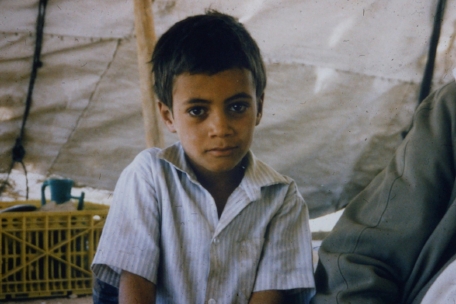I first visited Masada in 1984, arriving as most visitors did by the modern Israeli-built road on its eastern side which follows the edge of the Dead Sea. Access to the top of the Masada stronghold was only via either the cable car up from the eastern side or the steep footpath. The Roman army who under General Silva vanquished the Jewish zealots at Masada came in from the western side and built their famous ramp and mounted their final assault over this western edge.
By 1990, when this photograph was taken, it was extremely unusual for travelers to be in a position to see and photograph Masada's western side from the Judaean Desert. It's an inhospitable landscape, and close to the border with what was then called the Occupied West Bank (now Palestinian Territories). It's a national park and for obvious reasons protected - which means casual visitors and tourists are discouraged from anything other than organised tours along main routes - which even today takes them inevitably along the main road along the Dead Sea and to the eastern side of Masada and the convenience of a cable car ride.
The first time I visited the fortress I arrived in the normal way, along the Dead Sea road, into the car park, and I climbed up the footpath on the eastern side. It was August. It was hot, over 40 degrees. The ascent - the 'snake path' - was steep, twisting and rocky. I carried water, and water was provided along the footpath at standpipes. I arrived at the summit, heard a talk in English about Yigael Yadin's excavations and the importance of Masada to the modern State of Israel, and peered over the western side to the awesome remains of the ramp that the Roman army has built nearly 2,000 years earlier by which they breached the top of the Jewish defences. As Josephus tells us, the Jews chose to die rather than surrender.
It lives with you, that kind of story. Not just as a visitor to this place of historical memory, but as an archaeologist fascinated with landscape and technology. What would this place look like from the perspective of the Roman legionary tasked with building the massive ramp that would eventually, after three long gruelling months, break the siege of Masada? I could look at the published plans and photographs of the time (pre-internet, of course), but they seemed lifeless and grey. I needed to be on the ground.
I was back in Israel in 1990, visiting the Dead Sea, and hanging around the town centre of Arad, one of the Israeli planned towns in the region where the Negev and Judaean Deserts overlap. I was waiting for the Egged bus down to the Dead Sea for a day of health-restoring sun and salt, when a jeep pulled up and the driver beckoned to me. He was a Masada park ranger, a Bedouin named - as I was to find out - Musa Salam. He smiled and offered me a lift.
His English wasn't great, and my Arabic worse at that time, so we stumbled through a conversation in basic Hebrew on the ride down through the arid deserts slopes and terrifyingly winding roads.
We met a few times after that, Musa taking me patiently to places I wanted to photograph. Masada was first - from the western side, approaching it through the desert, first by jeep and then on foot. And how strange it was to be talking in the language of the people who were encroaching on his traditional lands, as he took me to see that monumental symbol of a fight against oppression, sillouetted against a Dead Sea and the beautiful morning haze framing the Jordanian shoreline in the distance.
He also took me to see his own home in the Negev Desert, outside of Arad and near the road to Be'er Sheva. His family were in their summer quarters - he would later write to me with the help of a colleague to let me know that they had moved into their winter encampment between Arad and Masada.
Musa's family like so many Bedouin were melding old with new. He had a salaried job on the land, and his family were grazing camels and goats, growing field crops and living in portable tents. His young sons wore western clothes, his young daughters traditional Bedouin dress. At the time, one of my projects was researching the Gertrude Bell Photographic Archive for the region - important Victorian views of monuments and people, including the Bedouin - and it was extraordinary to be able to see at close quarters a non-touristy Bedouin home and to be able to compare the similarities and difference between 1899 and 1990.
All this was in 1990 during the Palestinian intifada, close to the border with the Occupied West Bank, and I was grateful to him and knew that I was very lucky. Musa was my friend and I'll not forget him.






